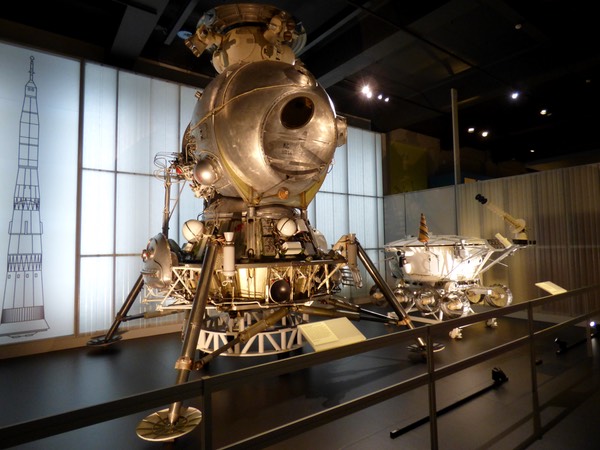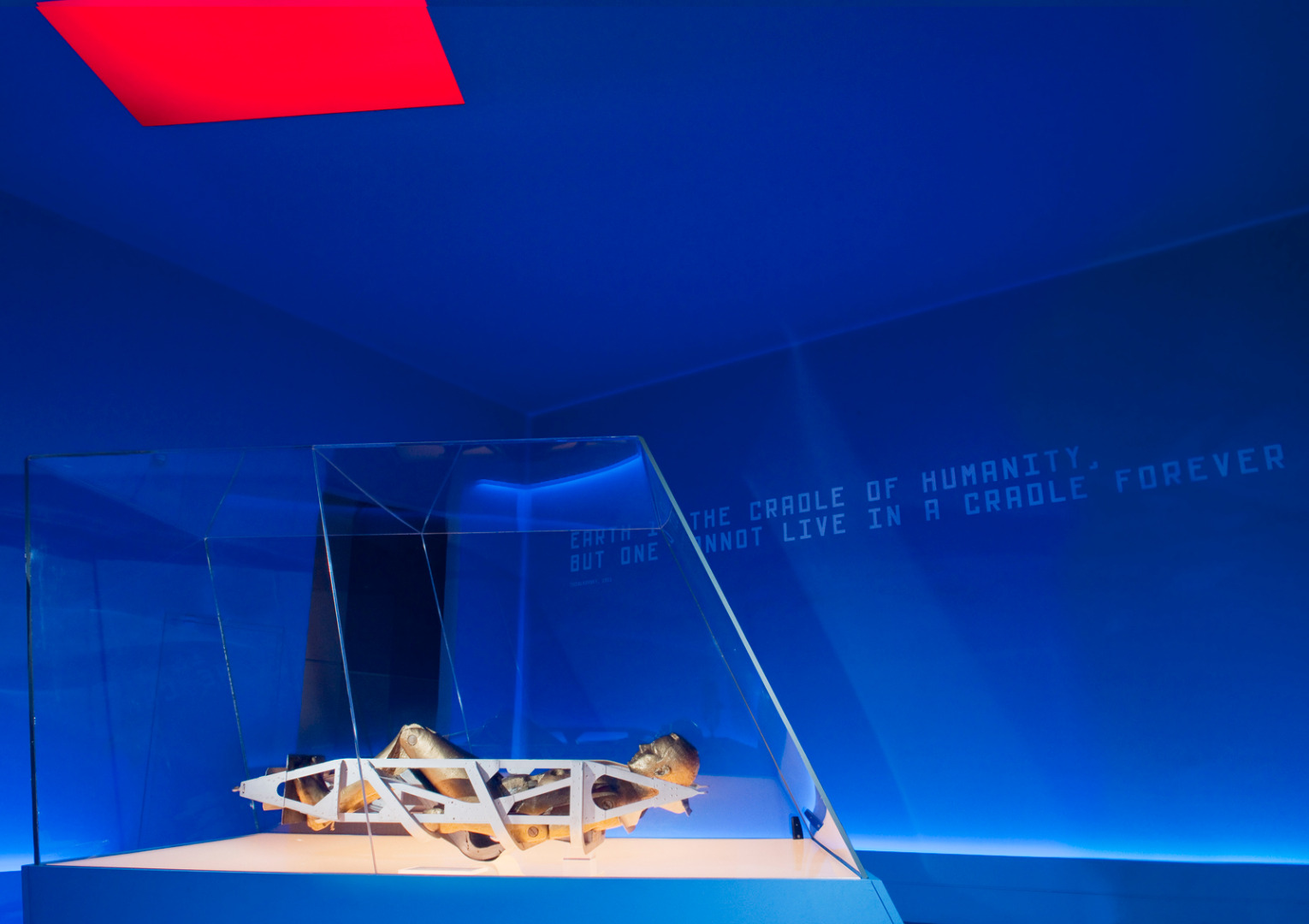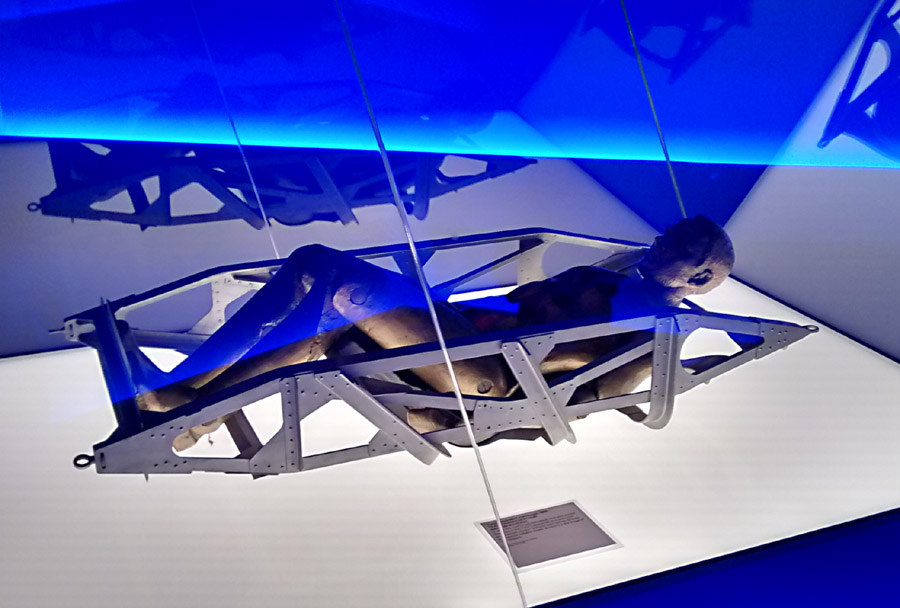It looks like you're using an Ad Blocker.
Please white-list or disable AboveTopSecret.com in your ad-blocking tool.
Thank you.
Some features of ATS will be disabled while you continue to use an ad-blocker.
10
share:
A really cool exhibit just ended its run in London. "Cosmonauts: Birth of the Space Age" was an exhibition that ran from September 18, 2015 to
March 13, 2016. It consisted of Soviet-era space artifacts and spacecraft. One of the cooler displays was a highly detailed engineering model of the
LK-3; a Soviet lunar module.

www.thespacereview.com...
What really intrigued me was the fact that the Soviets sent a mannequin into space which was designed to look like Yury Gagarin, who was the first human to travel into outer space. It traveled to the moon in 1969 on the Soviet Zond 7 Mission to measure radiation levels. This mannequin was on display as well. This would of been a very interesting exhibition to see!


thngs.co...

The lander, five meters tall, was designed to accommodate a single cosmonaut to land on the Moon and lift off again. The level of detail visible, like cabling running along the vehicle’s exterior, makes it clear that this is not a model or low-fidelity mockup, but something close to actual flight hardware—hardware, though, that never flew as the Soviet Moon program stalled and was eventually cancelled.
www.thespacereview.com...
What really intrigued me was the fact that the Soviets sent a mannequin into space which was designed to look like Yury Gagarin, who was the first human to travel into outer space. It traveled to the moon in 1969 on the Soviet Zond 7 Mission to measure radiation levels. This mannequin was on display as well. This would of been a very interesting exhibition to see!


The FM-2 phantom mannequin was developed in the Research Institute of Medical and Biological Problems of the USSR Academy of Sciences in 1968. The mannequin was designed for the study of the effect of space radiation on the human body. The task was complicated by the fact that for the correct assessment of the radiation dose, it was necessary for the mannequin to respond to radiation in the same way as do the tissues of the human body. This explains the unusual choice of materials: wheat and sawdust.
thngs.co...
I'm still reading the links you posted. I just came back here to say thanks, this is interesting stuff. I can't stop looking at the LK-3 Lunar Lander.
Part of me feels some of it looks like two huge copper taffy pots on their side, stuck together. I find it hard to drag my eyes away from the LK-3.
Sometimes I feel we don't give the Russians enough credit for some of the more unique stuff they develop and come up with.
Sometimes I feel we don't give the Russians enough credit for some of the more unique stuff they develop and come up with.
edit on 16-3-2017 by Jerseymilker because: Edited to fix the name of the lander.
Looks like the last work of Sergei Korolev:
en.wikipedia.org...
en.wikipedia.org...
edit on 16-3-2017 by manuelram16 because: spell
originally posted by: Jerseymilker
I can't stop looking at the LK-3 Lunar Lander. Part of me feels some of it looks like two huge copper taffy pots on their side, stuck together. I find it hard to drag my eyes away from the LK-3.
The LK lunar Lander is very similar in concept to the Apollo Lunar Module, with each craft leaving behind the landing legs and landing platform when it came time to ascend again from the Moon, leaving only the crew cabin as the ascent vehicle. One difference is that the LK had only one engine that was used for both descent and ascent. The Apollo Lunar Module had separate descent and ascent engines.
One reason for this is that the Apollo ascent engine was made to work very simply, and thus hopefully work without fail. But the simplicity of the Apollo ascent engine also meant it was not designed to be used multiple times -- BUT it could be reliably counted on to work at least once during the ascent from the Moon, which would be the one time they absolutely, positively needed it to work.
From what I've read about the LK, its combination ascent/descent engine was designed to be able to work multiple times -- once for descent and once again for ascent. I'm not sure if this requirement of multiple firings also meant that it would be more complex, thus might be less reliable to work when it came time for the Russian cosmonauts to leave the Moon.
edit on 16/3/2017 by Soylent Green Is People because: (no reason given)
iirc the other main difference in the design of the Soviet lander was that it was intended to hold just one cosmonaut - potentially a very lonely end
if it all goes wrong!
And let's not forget the quirky little buggy standing next to LK-3. Lunokhod trundled many miles across the lunar surface and sent back some great photographs.
And let's not forget the quirky little buggy standing next to LK-3. Lunokhod trundled many miles across the lunar surface and sent back some great photographs.
What a great exhibit! I wish it would come here.
The LK lander was the only part of the Soviet manned lunar effort that actually flew. It flew (unmanned) successfully three times in Earth orbit. These missions were similar to the Apollo 5 unmanned test of our LM.
Encyclopedia Astronautica link to LK
As for the mannequin, here is the link to the published measurements from the Zond missions. Note the concluding statement:
"The comparison of the dosage evaluations with the permissible values allows the conclusion that, should no solar flare occurs (sic) seven-day flights along the trajectories of Zond-5 and 7 are safe from the radiation point of view."
The LK lander was the only part of the Soviet manned lunar effort that actually flew. It flew (unmanned) successfully three times in Earth orbit. These missions were similar to the Apollo 5 unmanned test of our LM.
Encyclopedia Astronautica link to LK
As for the mannequin, here is the link to the published measurements from the Zond missions. Note the concluding statement:
"The comparison of the dosage evaluations with the permissible values allows the conclusion that, should no solar flare occurs (sic) seven-day flights along the trajectories of Zond-5 and 7 are safe from the radiation point of view."
I find it sad that Russia just dropped all of their plans to land a man on the moon when USA beat them.
All of those years of work...
All of those years of work...
a reply to: Iamnotadoctor
They didn't so much drop everything as they did accept their failure. The USA had men on the moon and the USSR still couldn't figure out how to get their rocket to stop exploding. In 1969 they were likely several years and billions of dollars away from a manned landing.
They didn't so much drop everything as they did accept their failure. The USA had men on the moon and the USSR still couldn't figure out how to get their rocket to stop exploding. In 1969 they were likely several years and billions of dollars away from a manned landing.
originally posted by: Iamnotadoctor
I find it sad that Russia just dropped all of their plans to land a man on the moon when USA beat them.
All of those years of work...
They did not, the Russians continued to try and launch their N-1 rocket until 1974 when it was cancelled.
The last N-1 launch was in 1972, which exploded like the rest of them.
a reply to: Apollo16UVCS201
They almost got the N-1 engines working, though, but then the authorities' patience had ran out.
They almost got the N-1 engines working, though, but then the authorities' patience had ran out.
new topics
-
2024 Pigeon Forge Rod Run - On the Strip (Video made for you)
Automotive Discussion: 38 minutes ago -
Gaza Terrorists Attack US Humanitarian Pier During Construction
Middle East Issues: 1 hours ago -
The functionality of boldening and italics is clunky and no post char limit warning?
ATS Freshman's Forum: 2 hours ago -
Meadows, Giuliani Among 11 Indicted in Arizona in Latest 2020 Election Subversion Case
Mainstream News: 2 hours ago -
Massachusetts Drag Queen Leads Young Kids in Free Palestine Chant
Social Issues and Civil Unrest: 3 hours ago -
Weinstein's conviction overturned
Mainstream News: 4 hours ago -
Supreme Court Oral Arguments 4.25.2024 - Are PRESIDENTS IMMUNE From Later Being Prosecuted.
Above Politics: 5 hours ago -
Krystalnacht on today's most elite Universities?
Social Issues and Civil Unrest: 5 hours ago -
Chris Christie Wishes Death Upon Trump and Ramaswamy
Politicians & People: 6 hours ago -
University of Texas Instantly Shuts Down Anti Israel Protests
Education and Media: 8 hours ago
top topics
-
Krystalnacht on today's most elite Universities?
Social Issues and Civil Unrest: 5 hours ago, 8 flags -
Weinstein's conviction overturned
Mainstream News: 4 hours ago, 6 flags -
University of Texas Instantly Shuts Down Anti Israel Protests
Education and Media: 8 hours ago, 5 flags -
Supreme Court Oral Arguments 4.25.2024 - Are PRESIDENTS IMMUNE From Later Being Prosecuted.
Above Politics: 5 hours ago, 5 flags -
Massachusetts Drag Queen Leads Young Kids in Free Palestine Chant
Social Issues and Civil Unrest: 3 hours ago, 4 flags -
Meadows, Giuliani Among 11 Indicted in Arizona in Latest 2020 Election Subversion Case
Mainstream News: 2 hours ago, 4 flags -
Any one suspicious of fever promotions events, major investor Goldman Sachs card only.
The Gray Area: 10 hours ago, 2 flags -
Chris Christie Wishes Death Upon Trump and Ramaswamy
Politicians & People: 6 hours ago, 2 flags -
Gaza Terrorists Attack US Humanitarian Pier During Construction
Middle East Issues: 1 hours ago, 2 flags -
God's Righteousness is Greater than Our Wrath
Religion, Faith, And Theology: 15 hours ago, 1 flags
active topics
-
University of Texas Instantly Shuts Down Anti Israel Protests
Education and Media • 179 • : Irishhaf -
Candidate TRUMP Now Has Crazy Judge JUAN MERCHAN After Him - The Stormy Daniels Hush-Money Case.
Political Conspiracies • 776 • : Vermilion -
Gaza Terrorists Attack US Humanitarian Pier During Construction
Middle East Issues • 15 • : Irishhaf -
Massachusetts Drag Queen Leads Young Kids in Free Palestine Chant
Social Issues and Civil Unrest • 9 • : theatreboy -
Meadows, Giuliani Among 11 Indicted in Arizona in Latest 2020 Election Subversion Case
Mainstream News • 5 • : Disgusted123 -
God's Righteousness is Greater than Our Wrath
Religion, Faith, And Theology • 29 • : Topcraft -
2024 Pigeon Forge Rod Run - On the Strip (Video made for you)
Automotive Discussion • 4 • : TheInvisibleRedneck -
Chris Christie Wishes Death Upon Trump and Ramaswamy
Politicians & People • 18 • : FlyersFan -
Breaking Baltimore, ship brings down bridge, mass casualties
Other Current Events • 488 • : xuenchen -
Krystalnacht on today's most elite Universities?
Social Issues and Civil Unrest • 3 • : StudioNada
10
